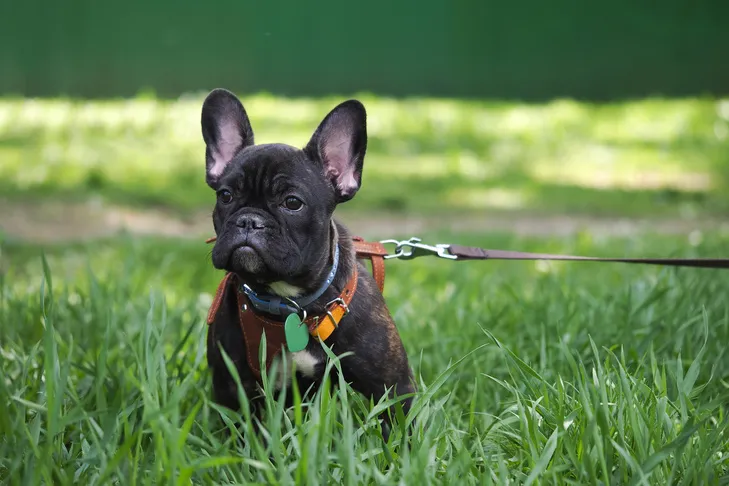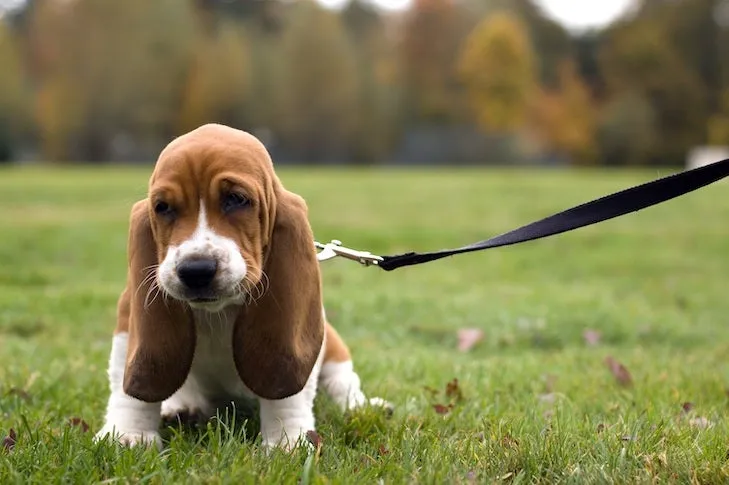Many new dog owners assume that puppies instinctively know how to walk politely on a leash. However, this crucial skill is something that must be taught and reinforced through consistent training. Mastering polite leash walking is an invaluable skill that will enhance every walk you take with your canine companion, making outings enjoyable for both of you. Dog training expert and AKC Family Dog columnist Kathy Santo shares foundational tips for teaching your puppy to master the leash.
Teaching your puppy to walk calmly beside you on a leash is a journey that requires patience, positive reinforcement, and consistent effort. It not only ensures pleasant walks but also reinforces your bond with your dog, establishing clear communication and trust. A well-trained puppy is a joy to walk, turning what could be a frustrating chore into a rewarding experience. how to teach your dog to lay down is another fundamental command that can complement leash training by teaching your puppy control and focus.
Training Your Puppy to Walk with a Leash: Building the Foundation
Establishing a solid foundation is key to teaching your puppy proper leash etiquette. By breaking down the training into manageable steps, you can help your puppy gradually adapt to the leash and associate it with positive experiences.
Introduce the Collar/Harness and Leash
Begin by familiarizing your puppy with wearing a collar or a harness and a leash. Allow them to wear these items for short periods while indoors, ideally during playtime or when you’re giving them treats. The goal is for your puppy to associate their collar and leash with positive experiences like food and fun, making them comfortable with the equipment before formal training begins. This initial positive association is crucial for future success.
Teach a Cue
Introduce a consistent sound cue that signals “Food is coming!” This could be a clicker sound, a specific word like “yes,” or even a tongue cluck. In a quiet, distraction-free environment, with your puppy wearing their collar and leash, make the sound. The instant your puppy looks at or turns towards you, reward them immediately with a treat. Through repetition, your puppy will learn to not only look at you but also come over for the treat upon hearing the cue. This establishes a vital communication link.
Encourage Your Puppy to Come To You
Once your puppy understands the cue, start incorporating movement. While they are on their way to you, still wearing their leash and collar, back up a few paces. Reward them enthusiastically when they reach you. Gradually increase the distance, continuing this progression until your puppy consistently comes and walks several paces with you after hearing the cue. Remember that puppies have limited attention spans, so keep training sessions brief and positive, ending before they become mentally exhausted.
Practice Indoors
With the “come to you” command established, move your practice sessions to a room with minimal distractions. The sensation of the leash around them, even without external elements, will provide a sufficient challenge. Continue to offer treats and verbal praise as your puppy learns to follow you willingly while wearing the leash. This controlled environment builds confidence before facing the complexities of the outside world.
Transition to Outdoors
Now, it’s time to test your puppy’s developing skills in an outdoor setting. This step introduces a new level of challenge due to the myriad of sounds, smells, and sights. Be patient and keep initial outdoor walks short to avoid overwhelming your puppy. During the walk, if you notice your puppy is about to lunge or become distracted – you’ll learn to anticipate this by keeping a watchful eye on them – use your cue sound and take a few steps away. Reward them with a treat for following you, reinforcing their focus on you amidst distractions.
Choosing a durable and comfortable leash is crucial for effective outdoor training, ensuring both your puppy’s safety and your control. Regularly checking the leash for wear and tear is also important to prevent unexpected breaks during walks. my dog keeps breaking out of his crate highlights the importance of secure and appropriate confinement, which can indirectly support leash training by building good habits around boundaries.
 French bulldog puppy in a harness sitting in tall green grass on a leash for a walk.
French bulldog puppy in a harness sitting in tall green grass on a leash for a walk.
Troubleshooting Common Leash-Walking Issues
Even with a strong foundation, puppies, like all dogs, will encounter new challenges as they mature, explore different environments, and encounter novel distractions. Learning how to manage these common leash-walking issues will make your walks more enjoyable and help your puppy develop into a well-behaved companion. Teaching them loose-leash walking is not only pleasant but also essential for them to potentially pass tests like the Canine Good Citizen. The AKC GoodDog! Helpline offers valuable advice for these situations.
If Your Puppy Pulls
When your puppy starts pulling in the opposite direction, immediately stop moving and turn yourself into “a tree.” Stand completely still and refuse to budge until your puppy returns to your side and the leash slackens. Never yank or jerk the leash, or drag your dog along. For persistent pullers, alternative training tools such as front-hook harnesses or head halters can be very effective as they redirect the dog’s pulling power without causing discomfort. Understanding how to get your dog to stop jumping on you shares principles of consistency and redirection that are also applicable to leash training.
If Your Puppy Lunges
If your puppy attempts to lunge at something during a walk—another dog, a passing car, or a skateboarder—proactive intervention is key. Anticipate their reaction and try to redirect their attention with a treat before they have a chance to lunge. Increase the distance between your puppy and the trigger, staying alert and prepared. While this behavior might be more common in certain breeds, like herding dogs, any puppy can be startled or overstimulated. Prevention through distance and redirection is always better than reaction.
Stopping unwanted behaviors like jumping requires a similar approach of consistent training and positive reinforcement. stop your dog from jumping on guests provides further insights into managing overexcitement and redirecting a dog’s focus.
 Basset Hound puppy sitting in the grass on lead.
Basset Hound puppy sitting in the grass on lead.
If Your Puppy Barks
Some puppies develop a habit of barking excessively at other dogs during walks. This behavior is often a symptom of insufficient exercise or mental stimulation. Ensure your puppy receives the appropriate amount of physical activity and mental enrichment suited for their age and breed. If barking persists, apply a similar strategy to lunging: create distance from the trigger (the other dog) and offer treats before your puppy starts barking. Over time, they will learn to associate seeing other dogs with turning their attention back to you for a reward, rather than barking. Learning how to get dog to stop barking at other dogs directly addresses this challenge with practical solutions.
Conclusion
Teaching your puppy to walk politely on a leash is a foundational aspect of responsible dog ownership that significantly enhances your shared life. By patiently introducing equipment, consistently using positive reinforcement, practicing in various environments, and proactively addressing common issues like pulling, lunging, and barking, you can guide your puppy to become a confident and well-behaved walking companion. Remember to always keep treats on hand for random reinforcement of good behavior, fostering a positive association with every outing. The journey requires dedication, but the reward of harmonious walks is well worth the effort. For persistent challenges, professional guidance can offer tailored solutions, ensuring your puppy’s success on the leash.
